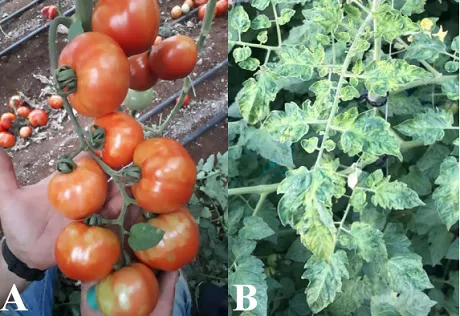TBRFV is a new tomato tobamovirus identified for the first time in Israel in late 2014. It was then reported in Jordan (2015), Mexico (2018), California (2018), Germany (2018), Palestine (2019) and Italy (2019).
To share insights on the virus and prevention of contamination, HortiDaily talked to Giuseppe Parrella, researcher at the CNR Institute for the Sustainable Protection of Plants, Portici (NA) section, to learn more about it.
What are the main characteristics of the TBRFV and what sets it apart from other tomato tobamoviruses?
Giuseppe Parrella (GP): The Tobamovirus genre includes viruses with very similar biological characteristics:
- rigid symmetrical particles of similar sizes (300 nm ca.);
- transmission via infected seed, contact between contaminated surfaces (plant, tools, clothes, etc.) and healthy plants and via infected propagation material (plantlets and grafted plants);
- infectivity is retained for a long time, so seeds can remain contaminated for a long time (the exterior and even the endosperm) as well as as any surface contaminated with infected plant juice and contaminated vegetable residues in the soil.
Nonetheless, while the tobacco mosaic virus (TMV) and tomato mosaic virus (ToMV), i.e. the most common tomato tobamoviruses, are effectively controlled with the Tm-22 resistance gene commonly used for all greenhouse tomato hybrids, ToBRFV can cause serious symptoms also in resistant genotypes.
Mechanical transmission occurs very easily in tomatoes, so particular attention must be paid not to favor transfers via infected material (plants, surfaces, clothes and tools).
The virus can spread especially during transplant operations or during the various production phases when plants are regularly handled for tying, winter pruning, defoliation, etc.
The infection can also start from infected fruits handled not only in the fields (e.g. during harvesting) but also in the various collection and consumption facilities (supermarkets, markets, canteens, etc.).
 Fig. 1 - TBRFV: symptoms of tomato fruits (A) and leaves (B)
Fig. 1 - TBRFV: symptoms of tomato fruits (A) and leaves (B)
What are the symptoms caused by TBRFV?
GP - They are very similar to those caused by TMV and ToMV on susceptible tomato genotypes (those without the Tm-22 gene).
A green mosaic pattern can develop on the leaves (Fig. 1 B), with a variable intensity depending on the case and often associated with deformation, foliar lamina reduction and at times accentuated whiptail.
The fruit that sets, considering that the percentage of flower abortion can be rather high, can have small grades and a wrinkly surface, while the color can be considerably affected by symptoms similar to "blotchy ripening": i.e. pale areas in contrast with the normal color (Fig. 1 A).
All this can be associated to dark necrotic spots, usually slightly sunken. Another common symptom is discoloring, browning or, in the most serious cases, desiccated sepal tips during the initial fruit development phases.
What is extremely important to know is that, if the symptoms described above are observed on resistant tomato genotypes (those with the Tm-22 gene), these must be considered as the probable start of an infection caused by TBRFV.
What to do if a TBRFV infection is suspected?
GP - First of all, verify whether the symptoms observed correspond to those described. If they do, isolate the suspected plants as well as those within 1.5 meters and start handling plants using all the necessary phitosanitary precautions: lab coats, disposable overshoes and gloves that must be kept inside the greenhouse; disinfectants for the hands and tools to be used every time a new plant is handled, etc.
If the symptoms are observed on resistant tomato genotypes, it is even more probable that the infection is caused by ToBRFV. In this case, contact a specialized lab that can identify ToBRFV specifically (eg. the IPSP-CNR virology laboratory in Via Università 133, Portici (NA) headed by Dr Giuseppe Parrella).
In Italy, what is being done on a regional level?
GP - In order to tackle and contain this and other phytosanitary emergencies, Regione Campania, the CNR Institute for the Sustainable Protection of Plants (IPSP-CNR), the Council for Research in Agriculture and Agricultural Economy Analysis (CREA) in Caserta and the Department of Agriculture at the University of Naples "Federico II", have agreed on a protocol to set up a "Unit for the coordination and strengthening of surveillance, research, testing, monitoring and training activities in the phytosanitary field" (URCoFi).
Activities to monitor and diagnose TBRFV have been entrusted to IPSP-CNR (Headed by Dr Giuseppe Parrella; tel. 081 7753658 int. 12). The institute set up a molecular diagnosis protocol specific for ToBRFV.
